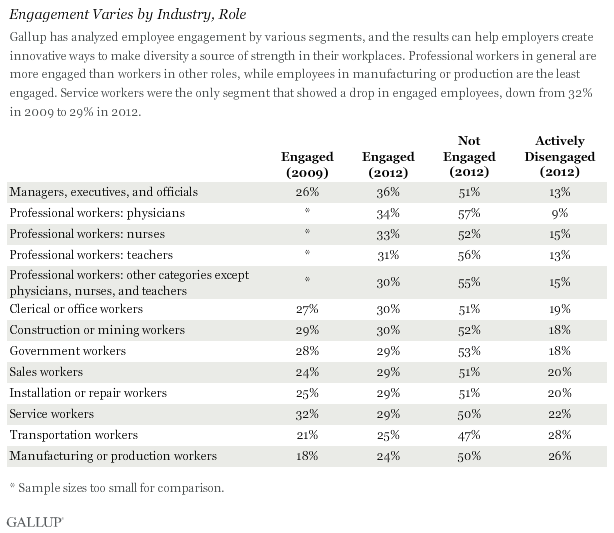While the world was waiting out the Great Recession, managers and executives in the U.S. were gunning their engines. More than one-third (36%) of them were engaged in their jobs in 2012, up 10 percentage points from 2009.
There's no one right way to engage everyone -- no one-size-fits-all approach.
It may be that executives and managers felt motivated and empowered by the challenges of leading and were ready to burn rubber when the economic turmoil settled down. Or maybe they just have more job security than those they lead.
Whatever the case, this example proves a point that extensive Gallup research has been showing for years: The type of occupation employees hold or the industry they're in relate to engagement when studied at an aggregate level. Also, employee engagement can vary substantially from company to company and from workgroup to workgroup.
Gallup has analyzed employee engagement results by various segments to help employers create innovative ways to meet their workers where they are. Recent studies conducted with various samples of the U.S. population show just how different employees can be. Used conscientiously, these data can help leaders make diversity a source of strength -- rather than division -- in their workplaces.
Professional workers have highest engagement; manufacturing or production employees are the least engaged
As noted above, managers and executives exited the recession with high levels of employee engagement; in fact, this group had the highest levels of engagement among the segments Gallup measured. Professional workers in general are at the higher end of the engagement spectrum and saw a modest two-point increase in engagement levels from 2009 to 2012.
Employees in manufacturing or production are the least engaged, possibly because the traditional management mentality in these industries tends to put process ahead of people. Still, their engagement has increased by six points since 2009. Workplace engagement is similarly low for transportation workers, but this group had a four-point increase from 2009 to 2012.
Engagement among service workers dropped by three percentage points -- from 32% in 2009 to 29% in 2012. Flat consumer spending since 2008 has likely reduced growth opportunities for service workers, and some people may be taking such jobs out of necessity rather than choice. If so, they're not as likely to be using their talents and qualifications, which hurts their potential for being engaged in their jobs.

Consider the following points:
- The service worker job category saw a drop in engagement between 2009 and 2012, a period when other categories gained momentum. Leaders should be concerned about this because most service workers interact directly with customers every day. When these employees are actively disengaged at work, they could be broadcasting their negativity to every customer they encounter. Leaders with customer-facing employees must evaluate their engagement levels and take action immediately to protect their customer relationships.
- Employees in manufacturing and production are the least engaged. Gallup finds that managers continue to be the most powerful influence on workers' engagement levels, so investing in manager engagement tends to boost employee engagement -- and this could be particularly helpful in manufacturing and production environments. So would remembering that people are more important and more complex than the machinery they operate.
Getting everyone engaged
This study does indicate that certain industries may have trouble engaging workers, but that doesn't mean they can't do it. Gallup's client database shows tremendous engagement success in every industry. Persistent, targeted attention on engagement at the enterprise and workgroup levels can lead to growth, no matter what business a business is in.
The traditional approach to management suggests that leaders are better off treating all of their employees the same. Yet as human beings, employees are profoundly different from one another. Not only do employees' job category and industry relate to their engagement, but so do highly personal attributes such as age, gender, generation, education level, and tenure. Managers need to evaluate whether they're making the most of their employees' unique qualities.
Managing a diverse group of employees in various types of occupations can seem like a daunting challenge. There's no one right way to engage everyone -- no one-size-fits-all approach -- and engagement takes time. Even the best managers rarely see immediate returns on their engagement efforts.
But the best managers do recognize and understand the fundamental differences among their team members and the implications for the workplace. Great managers don't duck diversity; they're energized by its potential.